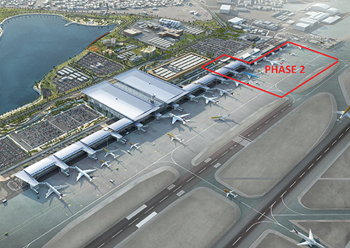
Phase Two includes construction of three Multiple Aircraft Ramp Systems (MARS) stands with piers, four remote stands and related airside infrastructure.
Terminal Phase Two nearly complete
01 January 2022
Construction work has well advanced on Phase Two of Bahrain International Airport’s $1.1-billion airport modernisation programme (AMP), following the launch of operations at the first phase of the new terminal building in January 2021.
Phase Two includes the demolition of the eastern part of the old terminal building to facilitate the extension of the new terminal building concourse and works at the landside areas. It also includes construction of three Multiple Aircraft Ramp Systems (MARS) stands with piers, four remote stands and related airside infrastructure, according to Hill International, a global project and construction management firm, which is providing project management services for the AMP.
These works started after the old terminal facility was decommissioned in February 2021.
 |
|
Phase Two works are under way at Bahrain International Airport. |
“Phase Two works are progressing in full swing and are planned to be completed in March 2022,” Uzair Wasif, Vice President and Project Director of Hill International, tells Gulf Construction.
“Phase Two is 82 per cent complete. With the completion of this phase, the terminal building will have 12 MARS aircraft stands,” he points out.
Bids have been opened for the demolition of the remaining portion of the old terminal with seven contractors having responded to the request for proposals (RFP), according to the Tender Board.
According to Wasif, this contract is expected to be award in late January 2022.
The Airport Modernisation Programme is the largest development in Bahrain’s aviation sector and is part of the kingdom’s Economic Vision 2030. It aims to enable increasing the passenger handling capacity at the airport to 14 million per year from the current nameplate of nine million per year.
The project is funded by Abu Dhabi Fund for Development (ADFD). Bahrain’s Ministry of Telecommunication and Transportation (MoTT) is the client and Bahrain Airport Company (BAC) is the client’s representative. ADPi is the design consultant and a joint venture of Arabtec/TAV is the main works contractor.
 |
|
The terminal building was completed under the first phase of the AMP. |
Work on the programme commenced in mid-2016. Phase One comprised a new 210,000-sq-m terminal building featuring premium-class check-in halls, check-in desks, passport control booths, E-gates, security lanes, a 9,000-sq-m duty-free retail space, premium-class lounges, food and beverage zones and 24 departure gates. The project involved the erection of nine MARS aircraft stands and included ancillary facilities such as a central utility complex, multi-level car parking and related airside and landside facilities, says Wasif.
Five packages were critical to meeting Phase One’s handover date, he says, noting the team procured these packages on a design-build basis, which used a traditional design-bid-build delivery method, prior to the award of the main contract. The five design-build packages were: Baggage Handling System (BHS), Information and Communication Technology (ICT), Security and Screening Equipment (SSE), Passenger Loading Bridges (PLB), and Horizontal/Vertical Transportation Systems (HVTS).
COVID-19 impact
The Covid-19 pandemic presented several challenges and on site, this meant ensuring proper personal protection equipment (PPE) was always available and in use, and that labourers were screened for symptoms daily before beginning work. This helped to protect the workforce and minimise the risk of the virus spreading, says Hill International.
From a planning and management perspective, Hill coordinated with the MoTT, BAC, vendors, and contractors to find workarounds to supply chain bottlenecks and to maximise work during available hours.
“Much like the entire aviation industry, we had to adapt quickly to the new normal of Covid-19. We needed to make certain we were doing everything we could to help keep the project moving,” says Sharif Makki, Hill’s Director of Operations and Contracts Manager for the project.
Prior to the official opening of the new terminal, BAC meticulously checked the operational readiness of the Phase One facilities to ensure the safety and wellbeing of passengers and staff at the new facility.
- Towards a sustainable future
- Terminal Phase Two nearly complete
- Expo centre marks milestone
- Cebarco gears for 2022 with optimism
- Paschal formwork shows its versatility
- Reynaers builds on campaign success
- Bahrain Projects at a glance


